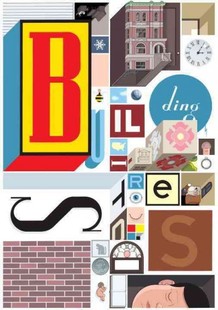In an age where eBooks seem to be taking over, Chris Ware has created a story that can only be experienced in print form. Building Stories is one single story told in graphic novel form in 14 distinct parts. Each part is different; for example, some are hardbound books, others are small comic strips, a few are pamphlets, and still more are large broadsheets. At the story’s center is an apartment building in Chicago in 2000. The building has 3 floors, with one apartment on each floor. While some pieces follow all of the residents, the main focus of the story is on the life of the young, amputee who lives in the 3rd floor walk-up. The majority of Building Stories follows her both while she lived there and in decade before and after. We grow attached to her as we see her search for acceptance, love, and fulfillment. As a reader, you make your way through the story as you see fit. Ware does not impose an order on the 14 pieces to his tale. This creates a unique storytelling experience as every reader encounters the story in a different order. Readers familiar with Ware’s drawing style will also notice his trademark large headed characters, a bright color palate, and his use of the entire page to tell the story.That is pretty much the entire book in one paragraph. I do want to flesh out a few of the appeal factors here though.
This is a book for people who are worried that eBooks will take over the world of publishing. Because this graphic novel is actually a box filled with 14 pieces of a single story, it can only be read and experienced in print. In today's digitally, app fueled world, there is something comforting about sitting down with the box, choosing one of the 14 parts, and sitting down to experience it.
That is how you read any Ware book by the way, they are always an experience first, and a story second. You experience the genius in his art work and in the way he structures a story. Time flows freely here, like in all of his books, but the themes at the heart of his tale do not get lost in the tide of his style.
Here is an example of what I mean when I say that time flows freely. This graphic novel is written in a circle, with no beginning or end, but it is still a complete story. We see the characters at various points in their life, but we never see a beginning or end to their lives. We are there for a time, visiting them, being a part of their lives, and then leaving when we read whatever the last piece we, the readers, choose to end the story with. It's the classic "slice of life" story taken to a satisfying extreme.
Since Ware imposes no order on how the book is read, each reading produces a slightly different version of the same story. This makes it a great option for re-reading. In fact, I am normally not a re-reader and I am excited to read this again in a few months to get a new experience from the graphic novel.
Speaking of the story, in Building Stories the theme is also like his other works (most notably the brilliant Jimmy Corrigan: The Smartest Kid on Earth)-- how we all long for fulfillment, love and acceptance, and while we think we find it at times, in the long run, it slips through our fingers and we keep the search going.
That is not to say the tone of the story here is dark and depressing. It is melancholy overall, but there are moments of elation, joy, and contentment sprinkled throughout. As a result, you do not feel overwhelmed by disappointment and sadness. Also, Ware tells the story from a place of observation. We come to care for the characters, but we do not necessarily sympathize with them. I know that sounds confusing, but it describes Ware's narrative voice perfectly. We see them, watch them, even root for them at times, but we also know that they will not make the right choices in the end. But somehow, it is all wonderful and beautiful to observe.
The story here is realistic. With its free narrative structure, extremely well rounded and fleshed out characters for whom you know their deepest darkest secrets, and lack of a starting and ending point, Building Stories resembles the actual human experience more than any novel I have ever read. It is remarkable in this sense.
The Oak Park and Chicago setting will also appeal to many readers in this area. Real places are drawn and/or referred to, like The Book Table, the BPL's favorite book store.
Finally, for libraries, there are many cataloging issues with Building Stories. Click here for my post (with pictures) on how we handled it at the BPL.
Three Words That Describe This Book: episodic, layered, stylistically interesting
Readalikes: I have a couple directions you could go with suggestions here. First, the episodic nature of the 14 pieces, made Building Stories feel like a book of short stories. With its connected characters, melancholic tone, and realistic portrayal of the people in the story, it reminded me of Olive Kitteridge by Elizabeth Stout. Also, the old lady in Building Stories really reminded me of Olive herself. Click here for a book discussion report on this book.
Another similar title is The Elegance of the Hedgehog by Muriel Barbery which also revolves around the tenants of a single building and is reflective, melancholic, and character-centered.
In terms of graphic novels that are similar. I think the tone of Adrain Tomine and Daniel Clowes are similar to Ware. Click here for more from me on Clowes.
Three years ago I read the graphic novel Asterios Polyp by David Mazzucchelli. Click here to see the similarities.










No comments:
Post a Comment